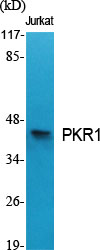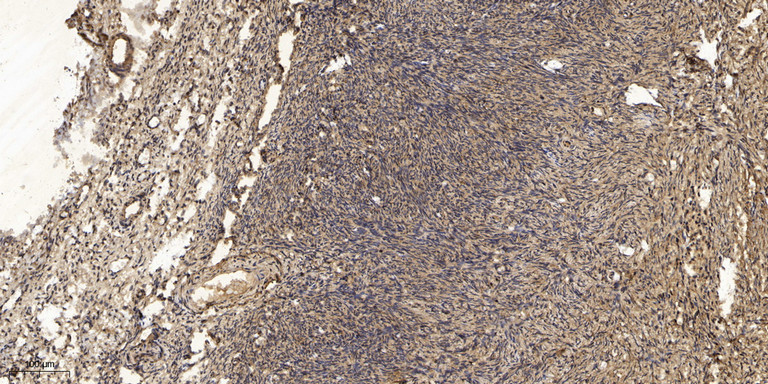PKR1 Polyclonal Antibody
- Catalog No.:YT3782
- Applications:WB;IF;ELISA;IHC
- Reactivity:Human;Mouse;Rat
- Target:
- PKR1
- Gene Name:
- PROKR1
- Protein Name:
- Prokineticin receptor 1
- Human Gene Id:
- 10887
- Human Swiss Prot No:
- Q8TCW9
- Mouse Gene Id:
- 58182
- Mouse Swiss Prot No:
- Q9JKL1
- Rat Gene Id:
- 192648
- Rat Swiss Prot No:
- Q8R416
- Immunogen:
- The antiserum was produced against synthesized peptide derived from human PKR1. AA range:19-68
- Specificity:
- PKR1 Polyclonal Antibody detects endogenous levels of PKR1 protein.
- Formulation:
- Liquid in PBS containing 50% glycerol, 0.5% BSA and 0.02% sodium azide.
- Source:
- Polyclonal, Rabbit,IgG
- Dilution:
- WB 1:500-2000; IF ICC 1:100-500;ELISA 1:5000-20000;IHC 1:100-500
- Purification:
- The antibody was affinity-purified from rabbit antiserum by affinity-chromatography using epitope-specific immunogen.
- Concentration:
- 1 mg/ml
- Storage Stability:
- -15°C to -25°C/1 year(Do not lower than -25°C)
- Other Name:
- PROKR1;GPR73;PKR1;Prokineticin receptor 1;PK-R1;G-protein coupled receptor 73;G-protein coupled receptor ZAQ;GPR73a
- Observed Band(KD):
- 45kD
- Background:
- prokineticin receptor 1(PROKR1) Homo sapiens This gene encodes a member of the G-protein-coupled receptor family. The encoded protein binds to prokineticins (1 and 2), leading to the activation of MAPK and STAT signaling pathways. Prokineticins are protein ligands involved in angiogenesis and inflammation. The encoded protein is expressed in peripheral tissues such as those comprising the circulatory system, lungs, reproductive system, endocrine system and the gastrointestinal system. The protein may be involved in signaling in human fetal ovary during initiation of primordial follicle formation. Sequence variants in this gene may be associated with recurrent miscarriage. [provided by RefSeq, Aug 2016],
- Function:
- function:Receptor for prokineticin 1. Exclusively coupled to the G(q) subclass of heteromeric G proteins. Activation leads to mobilization of calcium, stimulation of phosphoinositide turnover and activation of p44/p42 mitogen-activated protein kinase.,similarity:Belongs to the G-protein coupled receptor 1 family.,tissue specificity:Expressed in the stomach, throughout the small intestine, colon, rectum, thyroid gland, pituitary gland, salivary gland, adrenal gland, testis, ovary, brain, spleen, prostate and pancreas.,
- Subcellular Location:
- Cell membrane; Multi-pass membrane protein.
- Expression:
- Localizes to glandular epithelium, stroma and vascular endothelial cells of first trimester decidua (at protein level). Up-regulated in first trimester decidua when compared with non-pregnant endometrium. Expressed in the stomach, throughout the small intestine, colon, rectum, thyroid gland, pituitary gland, salivary gland, adrenal gland, testis, ovary, brain, spleen, prostate and pancreas.
Matrine alleviates spatial learning and memory impairment in diabetic mice by inhibiting endoplasmic reticulum stress and through modulation of PK2/PKRs pathway Neurochem Int. 2022 Mar;154:105289. IF Mouse 1:400 hippocampus
PK2/PKRs pathway is involved in the protective effect of artemisinin against trimethyltin chloride-induced hippocampal injury TOXICOLOGY Fei Cai WB,IHC Mouse brain tissues,Hippocampal tissues
- June 19-2018
- WESTERN IMMUNOBLOTTING PROTOCOL
- June 19-2018
- IMMUNOHISTOCHEMISTRY-PARAFFIN PROTOCOL
- June 19-2018
- IMMUNOFLUORESCENCE PROTOCOL
- September 08-2020
- FLOW-CYTOMEYRT-PROTOCOL
- May 20-2022
- Cell-Based ELISA│解您多样本WB检测之困扰
- July 13-2018
- CELL-BASED-ELISA-PROTOCOL-FOR-ACETYL-PROTEIN
- July 13-2018
- CELL-BASED-ELISA-PROTOCOL-FOR-PHOSPHO-PROTEIN
- July 13-2018
- Antibody-FAQs
- Products Images

- Western Blot analysis of various cells using PKR1 Polyclonal Antibody
.jpg)
- Western Blot analysis of COLO205 cells using PKR1 Polyclonal Antibody

- Western blot analysis of lysates from COLO cells, using PKR1 Antibody. The lane on the right is blocked with the synthesized peptide.

- Immunohistochemical analysis of paraffin-embedded human oophoroma. 1, Antibody was diluted at 1:200(4° overnight). 2, Tris-EDTA,pH9.0 was used for antigen retrieval. 3,Secondary antibody was diluted at 1:200(room temperature, 45min).



